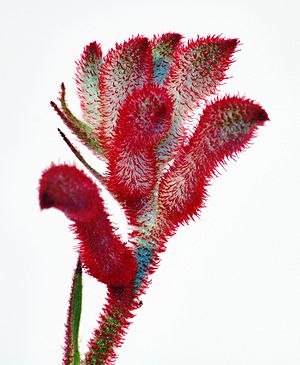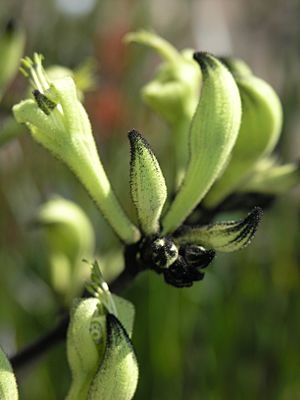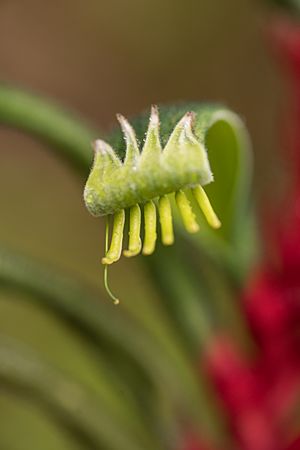Kangaroo paw facts for kids


Kangaroo paw is the common name for some special plants found only in the southwest part of Western Australia. These plants grow from underground stems called rhizomes. They are famous for their amazing flowers that look like a kangaroo's paw!
The flowers are shaped like tubes and are covered in soft, dense hairs. At the top, they open up with six claw-like parts. This unique shape is why they are called "kangaroo paw." These plants are also great at attracting birds.
Kangaroo paw plants have even been grown in other countries, like Japan. They are popular there as a new type of ornamental plant, especially on Okinawa Island.
The Story of Kangaroo Paw
The first person to study the Anigozanthos group of kangaroo paws was a French botanist named Jacques Labillardière. He found the plant in 1792 near a place called Esperance.
The famous red and green kangaroo paw was brought to England in 1833. A botanist named David Don described it in 1836. Its scientific name, manglesii, honors Robert Mangles. He was the first person to successfully grow this plant from a seed in his garden in England.
The red and green kangaroo paw is very special to Western Australia. It became the state's official flower on October 9, 1960. You can even see it on old stamps! An image of the red and green kangaroo paw was on a 5 pence stamp in 1962. This stamp celebrated the 1962 British Empire and Commonwealth Games held in Perth. It also appeared on a six-cent stamp in 1968, as part of a series showing state flowers.
Sometimes, plants can get sick, just like people. In 1990, a disease was found on kangaroo paw plants in Okinawa. This disease made the plants wilt and turn brown or black. White fuzzy spots would appear, and eventually, the plants would die. Scientists study these plant diseases to help keep plants healthy.
Growing Kangaroo Paws
Kangaroo paw plants naturally grow in southwestern Australia. You can find them from the Murchison River in the north down to Busselton and Mount Barker in the south. They also grow as far east as Lake Muir.
These beautiful plants are grown around the world to be picked and sold as cut flowers. Countries like the United States, Israel, and Japan grow them for this purpose. In Israel, for example, they grow kangaroo paws in greenhouses. They have also become very popular in gardens in California.
New Discoveries
Scientists are always researching kangaroo paw plants. Before 2020, they found ways to create many new colors for the flowers! Now you can find kangaroo paws in blues, purples, whites, and more. This research involves studying the plant's DNA to understand how it makes its colors.
Other research has looked into how parts of the plant might be used. Some studies suggest that substances from the plant could help make skin firmer by boosting collagen production.
Types of Kangaroo Paws
There are different kinds of kangaroo paw plants. They are grouped into two main families, or genera.
From the genus Anigozanthos:
- Anigozanthos bicolor (little kangaroo paw)
- Anigozanthos bicolor ssp. bicolor (two-coloured kangaroo paw)
- Anigozanthos bicolor ssp. decrescens
- Anigozanthos bicolor ssp. exstans
- Anigozanthos bicolor ssp. minor
- Anigozanthos flavidus (tall kangaroo paw)
- Anigozanthos gabrielae (dwarf kangaroo paw)
- Anigozanthos manglesii (red-and-green kangaroo paw)
- Anigozanthos manglesii ssp. manglesii
- Anigozanthos manglesii ssp. quadrans
- Anigozanthos pulcherrimus (golden kangaroo paw)
- Anigozanthos rufus (red kangaroo paw)
- Anigozanthos viridis (green kangaroo paw)
- Anigozanthos viridis subsp. terraspectans (dwarf green kangaroo paw)
- Anigozanthos viridis subsp. metallica (metallic green kangaroo paw)
From the genus Macropidia:
- Macropidia fuliginosa (black kangaroo paw)


